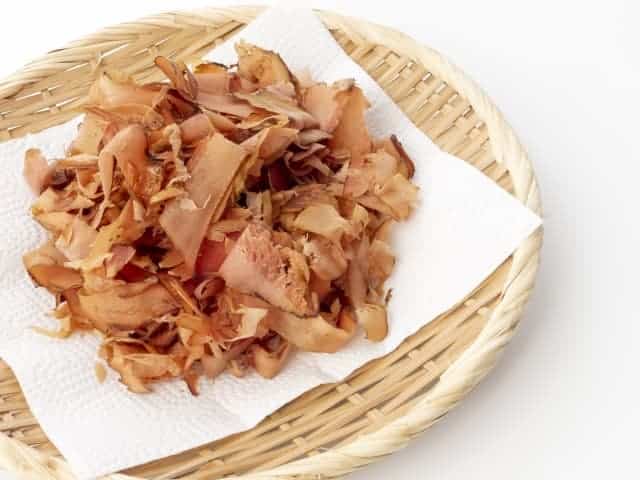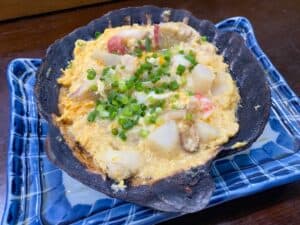History
The origin
The earliest known precursor to appear in the Kamakura-era text “Chujiru Riroku,” which mentions a liquid called “tashi-jiru” used in cooking, possibly for carp dishes. The next significant development came in the Muromachi period, when the text “Okusa-dono Yori Souden no Kikigaki” described the use of “nitsashi” – a broth made by simmering dried bonito (katsuobushi) in water, a technique very similar to modern one preparation.
In the Edo Period
Dashi in the Edo Period As the Edo period began, references to it became more common in culinary texts. The influential early Edo cookbook “Ryori Monogatari” mentions the use of “niban dashi,” or second extraction of dashi, and the use of konbu (seaweed) as an ingredient in addition to katsuobushi.
The Konbu Road and Regional Differences The establishment of the “Konbu Road” trade route in the mid-to-late Edo period facilitated the transportation of high-quality konbu from Hokkaido to other regions. This helped to solidify regional differences in dashi making, with eastern Japan preferring katsuobushi-based dashi and western Japan preferring konbu-based dashi.
In the Modern Era
As the Meiji period ushered in the modern era, home cookbooks began to feature dashi more prominently. Publications such as “Shomin Ryori Nenjū Sōzai no Shikata” and “Wa-yō Katei Ryōri-hō” detailed the use of both katsuobushi and konbu dashi, as well as the technique of making a “first” and “second” extraction of dashi, demonstrating the increasing popularity and standardization of it in home cooking.
Through these historical developments, it has evolved from a specialized cooking liquid to a fundamental component of Japanese cuisine, deeply rooted in the country’s culinary traditions and regional preferences. The versatility and umami-rich nature has ensured its enduring importance in Japanese food culture.
The Emergence of Dashi Types
Shiitake Dashi
Shiitake dashi is believed to have originated during the Kamakura period in the 13th century. The earliest known reference to it is found in the text “Tenzo Kyokun,” written by the Zen monk Dogen in 1237. In this work, Dogen recounts an anecdote from his travels in China, where a temple cook asked if any shiitake mushrooms had been brought on the ship, knowing that they could make a delicious dashi. This suggests that the use of shiitake as an ingredient had been established in Japan by the mid-13th century, probably through the introduction of Buddhist vegetarian cuisine (shojin ryori) from China.
Konbu Dashi
Konbu dashi is believed to have originated during the Kamakura to Muromachi periods, from the late 13th to mid-14th centuries. The earliest clear reference can be found in the late 14th-century text “Teikun Orai,” which mentions the popularity of “Ugajin Makonbu”-high-quality konbu from the Ugo region, which is now part of present-day Hakodate. This indicates that konbu had become a recognized ingredient for making flavorful dashi by the late Muromachi period.
Katsuobushi Dashi
Katsuobushi dashi, made from dried and smoked bonito flakes, appeared somewhat later than shiitake and konbu dashi, in the early Muromachi period of the 15th century. The earliest known written record of the term “katsuo-bushi” appears in the “Tanegashima-Kafu” text of 1513. This text, a genealogical record of the Tanegashima clan, was written in the Tanegashima region of Kagoshima Prefecture, an area historically known for its production of high-quality katsuobushi.
The delayed emergence of katsuobushi dashi compared to shiitake and konbu dashi is likely due to the more complex processing required to make katsuobushi. Drying, smoking, and curing the bonito into the dried flakes needed for dashi required specialized knowledge and techniques that took time to develop.
By the Muromachi period, these three iconic ingredients – shiitake, konbu, and katsuobushi – had all become established as fundamental components of Japanese cuisine, laying the foundation for the rich soup stock culture that would continue to evolve over the centuries.
Types of Dashi and Their Ingredients
Primary Types
Katsuobushi Dashi (かつおだし)
Katsuobushi (dried bonito flakes) is considered a “soul food” of Japanese cuisine, and the dashi made from it forms the foundation of Japanese cooking. It’s one of the most fundamental and essential soup stocks in Japanese cuisine.
Main Umami Component:
- Primary compound: Inosinic acid (nucleotide-based umami)
Characteristics:
- Rich, smoky flavor
- Deep umami taste
- Complex aroma profile
Recommended Dishes:
- Clear soups (Suimono/すまし汁)
- Chawanmushi (茶碗蒸し, savory egg custard)
- Any dish where dashi is the star ingredient
Kombu Dashi (昆布だし)
Kombu (kelp) is another cornerstone ingredient in Japanese soup-making. The flavor profile can vary significantly depending on the harvesting location and year, making it an interesting ingredient to explore and find your preferred variety.
Main Umami Component:
- Primary compound: Glutamic acid (amino acid-based umami)
Characteristics:
- Elegant, subtle flavor
- Clean, refined taste
- Mineral-rich profile
Recommended Dishes:
- Shojin Ryori (Buddhist vegetarian cuisine)
- Vegetable-based dishes
- Dishes requiring a delicate dashi base
Awase Dashi (合わせだし)
Awase dashi is a combination of katsuobushi and kombu dashi, creating a harmonious blend of both ingredients’ unique properties.
Main Umami Component:
- Combination of inosinic acid (from katsuobushi) and glutamic acid (from kombu)
- Creates a powerful umami synergy effect
Characteristics:
- Enhanced umami through combination
- Balanced flavor profile
- Most versatile of all dashi types
Recommended Dishes:
- Widely used in general Japanese cooking
- Perfect for most traditional recipes
- Excellent base for various Japanese dishes
Niboshi Dashi (煮干だし)
Made from dried sardines (usually Japanese anchovy or sardine), it is known for its distinctive fish flavor. The most common varieties use dried Japanese anchovies (katakuchi iwashi) or sardines (maiwashi).
Main Umami Component:
- Primary compound: Inosinic acid (same as katsuobushi)
Characteristics:
- Strong fishy aroma
- Less acidic than katsuobushi dashi
- Rich, deep flavor
Recommended Dishes:
- Miso soup
- Noodle broths
- Simmered dishes (Nimono)
Mixed Dashi (混合だし)
Created from a blend of various fish flakes such as mackerel (saba), horse mackerel (aji), and other dried fish products.
Characteristics:
- Complex flavor profile
- Rich umami taste
- Well-rounded body
Recommended Dishes:
- Udon and soba noodle soups
- Miso soup
- Simmered dishes
Shiitake Dashi (椎茸だし)
Made from the soaking liquid of dried shiitake mushrooms. For best results, rehydrate mushrooms in cold water, as high temperatures can result in bitter notes.
Main Umami Component:
- Primary compound: Guanylic acid (nucleotide-based umami, similar to inosinic acid)
Characteristics:
- Distinct mushroom flavor
- Earthy notes
- Natural sweetness
Recommended Dishes:
- Simmered dishes
- Somen noodles
- Vegetarian dishes
Preparation Tip:
For optimal results, rehydrate dried shiitake in cold water. While this takes longer, it prevents the bitter taste that can develop when using hot water.
Key Ingredients
Kombu (Kelp)

Japanese chefs appreciate kombu from the cold waters of Hokkaido for its superior quality. The three main varieties – Ma-kombu, Rausu kombu, and Rishiri kombu – each bring unique characteristics to dashi making. Experienced cooks prefer two-year-old kombu because it develops a higher concentration of glutamic acid, the compound responsible for its signature umami flavor. Before reaching the market, kombu undergoes careful drying and aging processes that enhance its flavor-imparting properties.
Katsuobushi (Dried Bonito)

Artisans create katsuobushi through an intricate process that involves drying and fermenting bonito with specific strains of mold. While bonito remains the traditional choice, producers also apply similar techniques to tuna, mackerel, and sardines. The finished product contains high levels of protein and inosinic acid, creating a deeply concentrated flavor that forms the backbone of many Japanese dishes. The fermentation process transforms the fish’s natural umami into something far more complex and profound.
Niboshi (Dried Sardines)

Japanese cooks rely on niboshi, made from a variety of small dried fish, to create robust broths. These dried fish impart a slightly bitter flavor that works particularly well in miso soup and hot pot dishes. The drying process concentrates the umami compounds while preserving the valuable inosinic acid content. Careful processing ensures that the fish retains its flavor-enhancing properties while developing a deeper flavor profile.
Ago (Flying Fish)

Ago stands out as a premium dashi ingredient due to its naturally low fat content. Artisans grill the flying fish before drying it for 4-5 days, a process that develops its refined, light flavor profile. This careful preparation enhances the umami compounds while creating a delicate broth. Producers must ensure thorough drying to prevent mold growth and preserve the fish’s subtle qualities.
Dried Shiitake Mushrooms

As the second most popular plant-based dashi ingredient after kombu, dried shiitake mushrooms play a crucial role in Japanese cuisine. They are especially prized in Buddhist vegetarian cuisine (shojin ryori), where they provide deep umami flavor without animal products. The drying process concentrates the mushrooms’ natural flavors and creates new flavor compounds. When making stock, chefs carefully rehydrate these mushrooms to extract their maximum flavor potential.















Comments